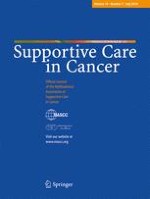Published in:

01-07-2010 | Original Article
Insight in the prediction of chemotherapy-induced nausea
Authors:
Joseph A. Roscoe, Gary R. Morrow, Ben Colagiuri, Charles E. Heckler, Bryan D. Pudlo, Lauren Colman, Karen Hoelzer, Andrew Jacobs
Published in:
Supportive Care in Cancer
|
Issue 7/2010
Login to get access
Abstract
Purpose
To identify risk factors for chemotherapy-related nausea.
Methods
We examined risk factors for nausea in 1,696 patients from three multicenter studies conducted from 1998 to 2004. All patients were beginning a chemotherapy regimen containing cisplatin, carboplatin, or doxorubicin. Nausea was assessed on a 1–7 scale four times a day for 4 days by diary.
Results
First, average nausea for breast cancer patients receiving doxorubicin (mean = 2.31) was significantly greater than for other patients receiving doxorubicin (mean = 1.82), patients receiving cisplatin (mean = 1.88), and patients receiving carboplatin (mean = 1.45), Ps < 0.01. Second, mean nausea decreased steadily with age, P < 0.0001. Third, patients rating themselves more susceptible to nausea had significantly more nausea (adjusted mean = 2.51) than patients rating themselves less susceptible (adjusted mean = 1.92) and were 2.8 times more likely to experience severe nausea, Ps < 0.0001. Fourth, expected nausea was a significant predictor of average nausea, P = 0.034, but not severe nausea, P = 0.31. Last, no evidence that gender is a significant predictor of nausea in 299 patients with gender neutral cancers, P = 0.35.
Conclusions
Specific patient characteristics, especially younger age and perceived susceptibility to nausea, can help clinicians in the early identification of patients who are more susceptible to treatment-related nausea.